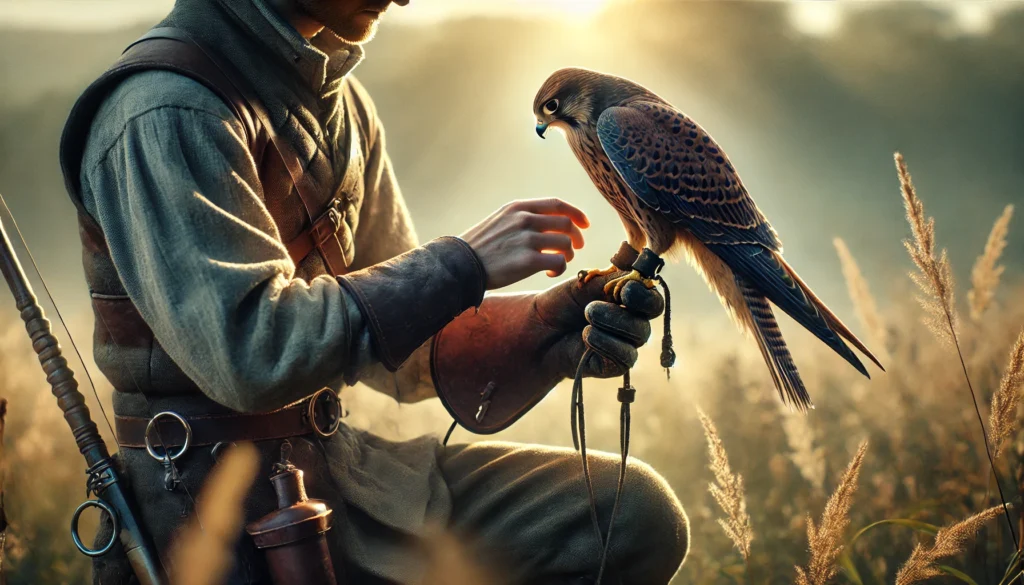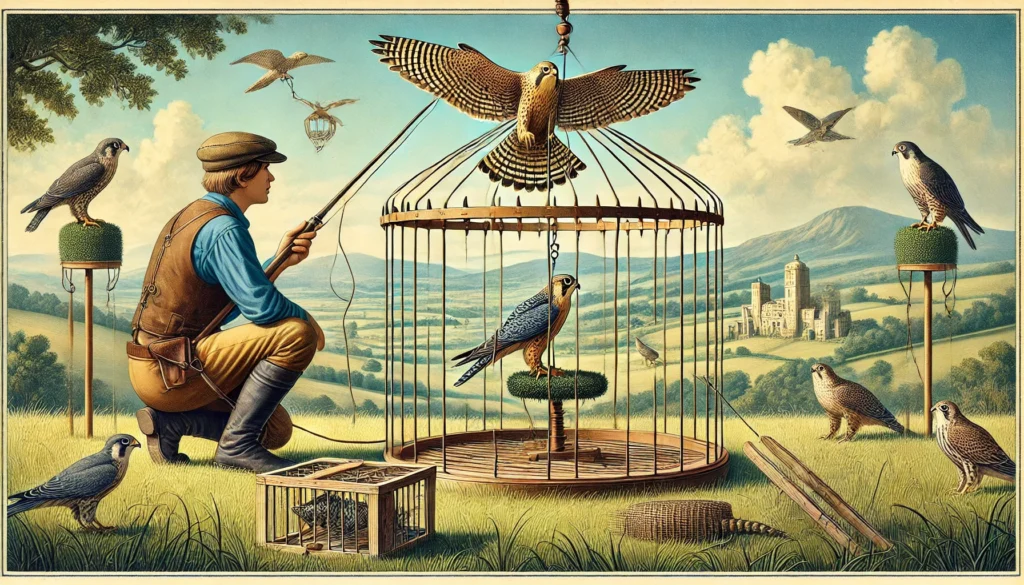Free-Flight Techniques in Falconry
- Understand the Basics: Knowing fundamental falconry techniques is key to successful bird handling.
- Training Your Bird: Proper training ensures safety and trust between you and your bird.
- Equipment Essentials: Using the right equipment, like hoods and jesses, is crucial.
- Health Check: Regular health checks keep your bird in top flying condition.
- Weather Conditions: Always consider weather conditions before a free flight.
- Recall Training: Teaching your bird to return on command is important and rewarding.
- Safety First: Always prioritize safety for both the bird and the handler.
- Patience is Key: Building a strong, trusting relationship takes time and patience.
- Environmental Awareness: Understanding the environment helps in planning flights and ensuring bird safety.
- Continuous Learning: Stay updated with the latest techniques and train regularly.
Discovering the Magic of Free Flight Techniques in Falconry
Top o’ the mornin’ to ya! Imagine wandering through the lush, green hills of Ireland, feeling the cool earth beneath your feet. Like a shepherd tending to his flock, you spot a majestic falcon soaring gracefully through the clear blue sky. This magnificent dance of freedom and control may seem like pure magic, but it’s actually the art and science of free flight techniques in falconry.
Here at Learn Falconry, we believe this ancient practice can open up new worlds for both novices and seasoned falconers alike. Free flight techniques are not just about letting your bird spread its wings; they’re about understanding the delicate balance between freedom and guidance. These skills are crucial for anyone who wants to build a strong, trusting relationship with their bird of prey.
Why should you keep reading? Well, just like the key to making the perfect Irish stew lies in knowing how to blend the ingredients just right, mastering free flight techniques can transform your falconry experience from ordinary to extraordinary. Our deep dive into these methods will show you how to foster a relationship filled with mutual trust and respect between you and your feathered friend. Ready to uncover the magic? Let’s get started!
Mastering Free-Flight Techniques in Falconry
Embark on an exhilarating journey into the world of free flight falconry! At Learn Falconry, we are passionate about teaching you the incredible skills needed to train your bird for free flight. This technique allows your falcon to soar through the skies, unhindered by tethers, and return to you with impeccable precision. But what exactly is this practice, and how does one master the art of falcon free flight?
Understanding Free Flight Falconry
Free flight falconry is the art of training a falcon to fly freely and hunt while responding to the falconer’s commands. This technique involves complex training that ensures the bird can return safely to its trainer. The process requires patience, dedication, and a deep understanding of the falcon’s behavior and instincts.
For a more in-depth look at the history and evolution of this ancient practice, explore our detailed History of Falconry page.
The Essentials of Free Flight Training
Step-by-Step Training Process
Free flight training begins with foundational elements such as creance work (a long, lightweight leash), lure flying, and positive reinforcement techniques. You can learn more about these methods on our Training a Falcon page.
- Creance Training: Initially, the falcon is flown on a long leash, giving it the freedom to fly while still being under the control of the falconer. This is crucial for building trust and ensuring the bird understands the boundaries.
- Lure Flying: This involves using a lure, typically a piece of meat fashioned to mimic a prey animal, to train the bird to return. It’s an engaging way for the falcon to practice hunting skills while staying connected to its trainer.
- Positive Reinforcement: Rewarding the falcon for desired behaviors fosters a reliable bond between the bird and the falconer. Check out our Positive Reinforcement Techniques section for more insights.
Equipment Required
Proper equipment is paramount in free flight falconry. From specialized hoods and gloves to tracking devices and perches, each tool plays a vital role. Discover the variety of tools you’ll need on our Falconry Equipment page.
- Telemetry and GPS Trackers: These help monitor the bird’s location during training sessions. Advanced technology such as GPS aids in tracking the bird’s movement over vast distances.
- Lures and Perches: Essential for recall training and ensuring a safe resting place for your bird.
Choosing the Right Falcon
Not all birds are suited for free flight; some species are better equipped for this technique. Investigate different species on our Species of Falcons page to find out which type might be best for you.
Legal and Ethical Considerations
Before starting your training, it’s vital to understand the legalities involved in falconry. Learn more about the regulations and ethical practices on our Legal Aspects of Falconry page.
Training a falcon for free flight is an art that requires knowledge, skill, and the right set of tools. Whether you’re a beginner or looking to refine your skills, Learn Falconry is here to guide you through every step of the process. For additional tips and detailed methods, visit our comprehensive section on Falconry Techniques.
Are you ready to let your falcon spread its wings? Start learning today and become a master of free flight falconry!
Understanding Free-Flight Techniques in Falconry
In the world of falconry, the art and science of training birds of prey to hunt in their natural environment, free-flight techniques are fundamental. Let’s learn about the essentials of practicing free-flight techniques.
Fundamental Techniques
1. Initial Training
Starting a young raptor on free-flight involves careful steps. The bird must first be trained to wear a hood and tether comfortably. The use of a creance, a lightweight cord, prevents a young bird from flying away too early. The process typically begins with short tethered flights, gradually increasing the distance until the bird reliably returns to the falconer.
2. Positive Reinforcement
Using food as a reward is crucial. Falconers keep detailed logs on their bird’s eating habits. By monitoring weight and feeding patterns, it’s easier to predict and manage their performance. A raptor’s motivation to return during free-flight sessions is often driven by hunger and the promise of rewarding meals.
Advanced Techniques
1. Flights with a Creance
Here’s a simplified example showing how the process of training with a creance can look like over the first two weeks:
| Day | Distance (Meters) | Total Flights |
|---|---|---|
| 1 | 5 | 10 |
| 2 | 10 | 10 |
| 3 | 15 | 10 |
| 4 | 20 | 10 |
| etc. | increases daily | 10 per day |
Each day, the distance is increased. This helps the raptor gradually adjust to flying longer distances and ensures they understand the command to return.
2. Variable Perches
To encourage adaptability, falconers use variable perching techniques. Different types of perches teach the bird to land on various surfaces. This can be practiced both in controlled environments and during real free flights. Switching from a standard perch to a tree branch or hand-held glove adds complexity to the bird’s routine, making them more versatile in hunting.
Tracking and Monitoring
1. Telemetry
Advanced free-flight sessions involve using telemetry equipment. Small, lightweight transmitters attached to the bird allow falconers to track their raptor over long distances. Here’s an example of telemetry range based on transmitter power:
| Transmitter Power (mW) | Range (km) |
|---|---|
| 5 | 8-10 |
| 10 | 15-20 |
| 25 | 30+ |
The higher the power, the greater the range, making it easier to ensure the bird’s safe return.
2. Data Logging
By logging flight data, falconers can analyze patterns in their raptor’s behavior. For instance, recording daily flights, durations, and success rates can offer insights into their bird’s progress and wellbeing.
| Month | Avg. Flight Duration (Minutes) | Success Rate (%) |
|---|---|---|
| January | 5 | 80 |
| February | 10 | 85 |
| March | 15 | 90 |
Over time, such data helps fine-tune training regimens to fit the bird’s unique needs and capabilities.
Practical Examples
1. Lure Training
A lure, often a piece of leather with meat attached, is swung in the air to mimic a flying prey. The raptor learns to chase and catch the lure. This technique reinforces hunting skills and ensures the bird associates the lure with a successful hunt.
2. Hunting Simulations
Simulation exercises can further hone the raptor’s natural instincts. For example, falconers might hide pieces of meat in fields, encouraging the bird to use its keen eyesight and agility to locate and capture the “prey.”
Equipment and Facility Management
Maintaining proper facilities and equipment is essential to successful free-flight training. Indoor housing (mews) and outdoor weathering areas need to be secure, spacious, and regularly inspected. This ensures the raptors stay healthy and uninjured.
| Facility Type | Requirements |
|---|---|
| Mews | Secure perches, ventilation |
| Weathering Area | Open space, secure fencing |
Using these guidelines, falconers can provide an optimal environment for their birds, supporting both their physical health and training needs.
Conclusion
Implementing free-flight techniques in falconry involves a combination of structured training, positive reinforcement, and thorough data monitoring. With the right approach and tools, falconers can effectively train and fly their birds, leading to a rewarding experience for both.
Mastering Free-Flight Techniques in Falconry
In summary, free-flight techniques in falconry are crucial for successful bird training and care. As up-and-coming falconers, it’s important to note the following key points:
- Registration and Exam Dates: Remember to register by April 10, 2024, for the falconry examination on April 12, 2024.
- License and Reporting: Keep your licenses up-to-date, with renewals every five years and annual report submissions each December 31.
- Rules and Regulations: Falconry practices are governed by both environmental conservation laws and federal regulations.
- Facilities and Training: Make sure your raptors have suitable housing and equipment that meet inspection standards.
- Association Support: Utilize resources from falconry associations to enhance your knowledge and skills.
By adhering to these guidelines, you can ensure a successful and rewarding experience in the art of falconry. Embrace the journey, treat your raptors with care, and soar towards mastering these timeless techniques.



